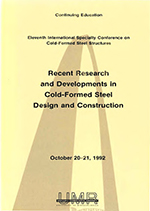Location
Saint Louis, Missouri
Session Dates
20 Oct 1992
Abstract
The use of composite beams which utilise steel beams together with a composite steel sheet/concrete floor slab is well developed. Many forms of steel profile are used and the form of attachment to the steel beam is generally by welded shear studs or shot-fired shear connectors. The design procedures for these beams require a knowledge of the shear capacity of the connectors which may be influenced by the type of profile being used for the beam. This shear capacity is often deduced from information obtained from standard push-off tests which mayor may not include in the test set-up the actual profile type to be used. There is variation between countries in the test procedures used for push-out tests; parametric studies on the sample size and loading procedures have not produced a definitive model. The proposed Eurocode 4 version has a test set up for the push-off tests which is broadly similar to past types but introduces an element of cyclic loading. The development of composite floors has seen improvements in profile design leading to more efficient shear transfer. Work has also been carried out to increase the load capacity for these slabs by the use of end anchorages. These anchorages which prevent the slip of the profile steel sheet relative to the concrete are generally shear connectors attached to the supporting beams through the profiled steel sheet. In the majority of practical design cases the connectors used for the composite beam will, designed for or not, be capable of providing some force at right angles to the beam axis in the direction in which the slab is spanning. In an early reference to this behaviour design account need only be taken if the connector was designed for such two-way action. It, therefore, appeared necessary to consider how this two-way or biaxial behaviour affected the capacity of the shear connector when designed to act either in one or both directions. Certain codes referred to the capacity in both directions as a function of the traditional push-off value but this has been demonstrated as not being the case.
Department(s)
Civil, Architectural and Environmental Engineering
Research Center/Lab(s)
Wei-Wen Yu Center for Cold-Formed Steel Structures
Meeting Name
11th International Specialty Conference on Cold-Formed Steel Structures
Publisher
University of Missouri--Rolla
Document Version
Final Version
Rights
© 1992 University of Missouri--Rolla, All rights reserved.
Document Type
Article - Conference proceedings
File Type
text
Language
English
Recommended Citation
Duffy, Chris T.; O'Leary, David; and Montourcy, Michel, "The Bi-axial Behaviour of Shear Connectors in Composite Slabs and Beams" (1992). CCFSS Proceedings of International Specialty Conference on Cold-Formed Steel Structures (1971 - 2018). 4.
https://scholarsmine.mst.edu/isccss/11iccfss/11iccfss-session11/4
The Bi-axial Behaviour of Shear Connectors in Composite Slabs and Beams
Saint Louis, Missouri
The use of composite beams which utilise steel beams together with a composite steel sheet/concrete floor slab is well developed. Many forms of steel profile are used and the form of attachment to the steel beam is generally by welded shear studs or shot-fired shear connectors. The design procedures for these beams require a knowledge of the shear capacity of the connectors which may be influenced by the type of profile being used for the beam. This shear capacity is often deduced from information obtained from standard push-off tests which mayor may not include in the test set-up the actual profile type to be used. There is variation between countries in the test procedures used for push-out tests; parametric studies on the sample size and loading procedures have not produced a definitive model. The proposed Eurocode 4 version has a test set up for the push-off tests which is broadly similar to past types but introduces an element of cyclic loading. The development of composite floors has seen improvements in profile design leading to more efficient shear transfer. Work has also been carried out to increase the load capacity for these slabs by the use of end anchorages. These anchorages which prevent the slip of the profile steel sheet relative to the concrete are generally shear connectors attached to the supporting beams through the profiled steel sheet. In the majority of practical design cases the connectors used for the composite beam will, designed for or not, be capable of providing some force at right angles to the beam axis in the direction in which the slab is spanning. In an early reference to this behaviour design account need only be taken if the connector was designed for such two-way action. It, therefore, appeared necessary to consider how this two-way or biaxial behaviour affected the capacity of the shear connector when designed to act either in one or both directions. Certain codes referred to the capacity in both directions as a function of the traditional push-off value but this has been demonstrated as not being the case.



